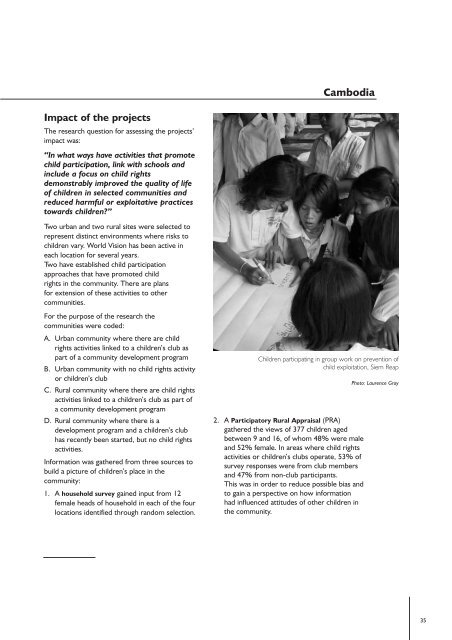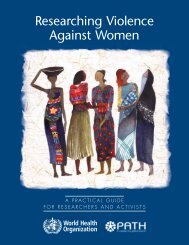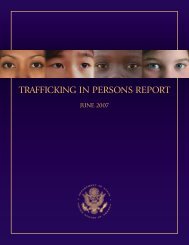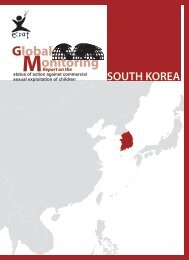Download PDF - Violence Against Children - East Asia and the ...
Download PDF - Violence Against Children - East Asia and the ...
Download PDF - Violence Against Children - East Asia and the ...
You also want an ePaper? Increase the reach of your titles
YUMPU automatically turns print PDFs into web optimized ePapers that Google loves.
Cambodia<br />
Impact of <strong>the</strong> projects<br />
The research question for assessing <strong>the</strong> projects’<br />
impact was:<br />
“In what ways have activities that promote<br />
child participation, link with schools <strong>and</strong><br />
include a focus on child rights<br />
demonstrably improved <strong>the</strong> quality of life<br />
of children in selected communities <strong>and</strong><br />
reduced harmful or exploitative practices<br />
towards children?”<br />
Two urban <strong>and</strong> two rural sites were selected to<br />
represent distinct environments where risks to<br />
children vary. World Vision has been active in<br />
each location for several years.<br />
Two have established child participation<br />
approaches that have promoted child<br />
rights in <strong>the</strong> community. There are plans<br />
for extension of <strong>the</strong>se activities to o<strong>the</strong>r<br />
communities.<br />
For <strong>the</strong> purpose of <strong>the</strong> research <strong>the</strong><br />
communities were coded:<br />
A. Urban community where <strong>the</strong>re are child<br />
rights activities linked to a children’s club as<br />
part of a community development program<br />
B. Urban community with no child rights activity<br />
or children’s club<br />
C. Rural community where <strong>the</strong>re are child rights<br />
activities linked to a children’s club as part of<br />
a community development program<br />
D. Rural community where <strong>the</strong>re is a<br />
development program <strong>and</strong> a children’s club<br />
has recently been started, but no child rights<br />
activities.<br />
Information was ga<strong>the</strong>red from three sources to<br />
build a picture of children’s place in <strong>the</strong><br />
community:<br />
1. A household survey gained input from 12<br />
female heads of household in each of <strong>the</strong> four<br />
locations identified through r<strong>and</strong>om selection.<br />
<strong>Children</strong> participating in group work on prevention of<br />
child exploitation, Siem Reap<br />
2. A Participatory Rural Appraisal (PRA)<br />
ga<strong>the</strong>red <strong>the</strong> views of 377 children aged<br />
between 9 <strong>and</strong> 16, of whom 48% were male<br />
<strong>and</strong> 52% female. In areas where child rights<br />
activities or children’s clubs operate, 53% of<br />
survey responses were from club members<br />
<strong>and</strong> 47% from non-club participants.<br />
This was in order to reduce possible bias <strong>and</strong><br />
to gain a perspective on how information<br />
had influenced attitudes of o<strong>the</strong>r children in<br />
<strong>the</strong> community.<br />
Photo: Laurence Gray<br />
35

















